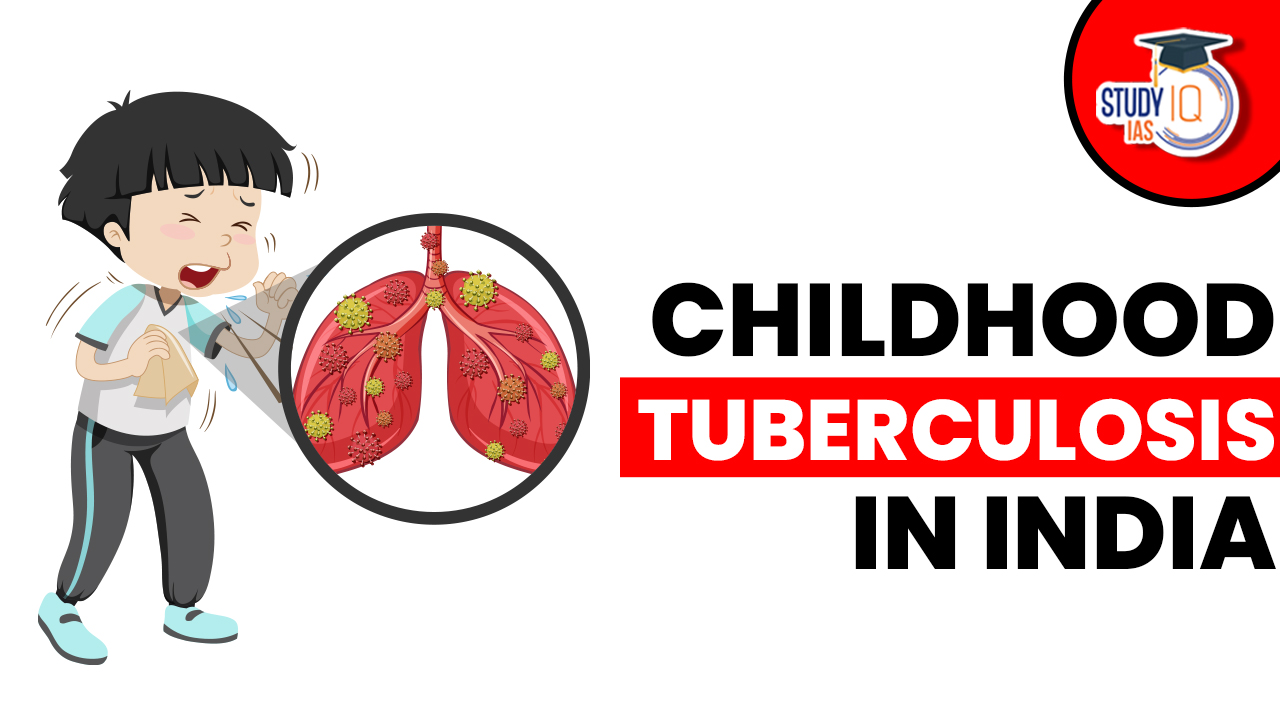Table of Contents
Context: With childhood Tuberculosis remaining a persistently significant issue in India, it is estimated that eliminating TB by 2025 could prove to be an exceedingly formidable task.
More on News
Burden of Childhood TB in India:
Childhood TB remains a significant challenge in India.
- Vulnerability and Mortality:
- Globally, TB is now the leading cause of death from infectious diseases among children.
- A study found that the estimated mortality rate for untreated children with TB is about 22%, and the case fatality ratio for children under five years old is 43%.
- Global Childhood TB Burden:
- Despite progress, there are critical gaps in detecting TB cases among children globally.
- Approximately 1.2 million children under 15 years of age fall ill with TB each year, and around 67 million children are infected, putting them at risk of developing TB later.
- However, around 56% of the 1.2 million children with TB are not detected.
- Childhood TB in India:
- It is estimated that nearly 0.34 million children under 15 years old in India develop TB every year, accounting for about 13% of the overall TB caseload in the country.
- Despite an increasing number of TB cases being detected and notified in India, children constitute only a small fraction (around 6%) of the total annual cases.
- Challenges in Diagnosis:
- While there were over 2.4 million total TB notifications in 2022, only 135,734 cases were pediatric TB, which is about 5.6% compared to the estimated contribution of 13%.

- Missed Cases:
- With an estimated 342,000 TB cases among children annually in India, the detection of only 135,734 cases in 2022 suggests that over 200,000 children with TB were potentially missed in that year alone.
- Despite active case finding efforts, the proportion of pediatric TB cases detected has remained constant at 6% for many years.
- Extrapulmonary TB: While pulmonary TB is more common in children and is easier to detect, up to 32% of TB cases in children are extrapulmonary, which presents more challenges in detection.
- BCG Vaccination: The BCG vaccination coverage for children has seen fluctuations during the pandemic. There was a decline in BCG vaccine coverage in India, which dropped from 92% in 2019 to 85% in 2020, and 84% in 2021 before increasing to 91% in 2022.
About Tuberculosis (TB)
- Tuberculosis (TB) is a bacterial infection spread through inhaling tiny droplets from the coughs or sneezes of an infected person.
- TB is caused by a bacterium called Mycobacterium tuberculosis, belonging to the Mycobacteriaceae family.
- Worldwide, TB is the 13th leading cause of death and the second leading infectious killer after COVID-19 (above HIV/AIDS).
- Transmission: TB spreads from person to person through the air. When people with lung TB cough, sneeze or spit, they propel the TB germs into the air.
- In humans, TB most commonly affects the lungs (pulmonary TB), but it can also affect other organs (extra-pulmonary TB).
- Cure: TB is a treatable and curable disease.
- Vaccine: Currently, Bacille Calmette-Guérin (BCG) is the only licensed vaccine available for the prevention of TB.
- BCG works well in some geographic locations and not so well in others.
- Generally, the farther a country is from the equator, the higher is the efficacy.
- It has a high efficacy in the UK, Norway, Sweden and Denmark; and little or no efficacy in countries on or near the equator like India, Kenya and Malawi, where the burden of TB is higher.
- Drug-Resistant TB: Sometimes drug-resistant TB occurs when bacteria become resistant to the drugs used to treat TB. This means that the drug can no longer kill the TB bacteria.

WHO Global Tuberculosis Report 2022
- Diagnosis and Mortality Globally: Around 10.6 million people across the world were diagnosed with tuberculosis (TB) in 2021, an increase of 4.5% from 2020, while 1.6 million patients died of the bacterial disease.
- Of the total TB deaths, 187,000 patients were also positive for HIV (human immunodeficiency virus).
- Nearly 82% of global TB deaths among HIV-negative people occurred in the African and South-East Asia regions.
- India and TB: With 28% cases, India was among the eight countries accounting for more than two-third (68.3%) of the total TB patients’ count.
- India accounted for 36% of the global TB related deaths among HIV negative people.
- India was among the three countries (along with Indonesia and the Philippines) that accounted for most of the reduction in 2020 (67% of the global) and made partial recoveries in 2021.
- Underreporting of Cases: Underreporting is more of a problem in India; the country is among the top five contributors – India (24%), Indonesia (13%), the Philippines (10%), Pakistan (6.6%) and Nigeria (6.3%).
- Rise in Drug-Resistant TB: The burden of drug-resistant TB (DR-TB) increased by 3% globally between 2020 and 2021, with 450,000 new cases of rifampicin-resistant TB (RR-TB) being reported in 2021.
About Drug-resistant tuberculosis (DR-TB)
- DR-TB refers to a form of tuberculosis where the bacteria causing the infection, Mycobacterium tuberculosis, are resistant to one or more of the standard anti-TB drugs.
- This resistance can occur due to factors such as improper treatment, incomplete courses of antibiotics, or exposure to TB drugs in suboptimal conditions.
- DR-TB is a significant concern because it complicates the treatment process and can lead to more severe forms of the disease that are harder to manage.
- There are two main categories of DR-TB:
- Multidrug-Resistant Tuberculosis (MDR-TB):
- MDR-TB refers to tuberculosis that is resistant to at least two of the most effective first-line drugs used in TB treatment, namely isoniazid and rifampicin.
- Treating MDR-TB requires a longer duration of treatment with a more complex regimen that includes second-line drugs, which are often more expensive, have more side effects, and are less effective.
- MDR-TB treatment success rates are generally lower compared to drug-sensitive TB.
- Extensively Drug-Resistant Tuberculosis (XDR-TB):
- XDR-TB is a more severe form of DR-TB that is resistant to the two most effective first-line drugs (isoniazid and rifampicin) as well as to fluoroquinolones and at least one of the three injectable second-line drugs (amikacin, kanamycin, or capreomycin).
- XDR-TB is even more challenging to treat than MDR-TB due to the limited availability of effective drugs and higher rates of treatment failure.
- Multidrug-Resistant Tuberculosis (MDR-TB):
Global Initiatives for TB
- Global Fund: It is a worldwide movement to defeat HIV, TB and malaria.
- Global Fund has become the single largest channel of additional money for global TB control.
- Stop TB Partnership: It is a United Nations hosted organization that takes initiatives to serve the needs of the people, communities, and countries affected by TB.
- It has 1500 partner organizations which include international, non-governmental and governmental organizations and patient groups.
- Global Plan to End TB 2023-2030: It maps out how to end TB as a public health challenge by 2030.
- It focuses on the need to invest in a new TB vaccine and approve it by 2025.
- It shall mobilize a global investment of US$250 billion for diagnosis and treatment of 50 million people with TB.
- SDG Goal: Ending the TB epidemic by 2030 is among the health targets of the United Nations Sustainable Development Goals (SDGs).
India’s Initiatives for TB
| Pradhan Mantri TB Mukt Bharat Abhiyaan |
|
| Ni-kshya Poshak Yojana |
|
| National TB Elimination Programme (NTEP) |
|
| National Strategic Plans for TB |
|
| TB Harega Desh Jeetega Campaign |
|
India’s Role in Ending TB by 2030
- Development of Adult TB Vaccine: The current vaccine, delivered at birth and useful particularly for children, is 100 years old. India should make efforts for a new vaccine like it did for the COVID 19.
- Anti-TB Drugs: There are only a few new anti-TB drugs available that have high costs. There is a dire need to move to an injection-free and shorter duration of oral pills for TB.
- Diagnostics: The of AI-assisted handheld radiology with 90-second reporting and 95% plus accuracy for diagnosing TB should be made available universally.
- Confirmatory diagnosis using molecular tests should be done.


 Future of Governance in Post-Maoist Indi...
Future of Governance in Post-Maoist Indi...
 Sabka Bima Sabki Raksha Amendment Bill 2...
Sabka Bima Sabki Raksha Amendment Bill 2...
 MP Police Answer Key 2025 Out at esb.mp....
MP Police Answer Key 2025 Out at esb.mp....

























